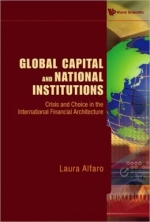Citation:

Abstract:
All managers face a business environment in which international and macroeconomic phenomena matter. International capital flows can significantly affect countries' development efforts and provide clear investment opportunities for businesses. During the 1990s and early 2000s, the world witnessed an explosion in capital flows at the global level. Gross foreign assets and liabilities stood at two or three times GDP for many countries, as compared to just two decades ago. This explosive growth, especially in emerging markets, has been fueled both by changes in world politics (e.g., the end of the Cold War, collapse of the Soviet Union, shifting political climate in China, and political changes in Latin America and Asia) and advances in technology. Private capital flows—debt finance, equity capital, and foreign direct investment (FDI)—became larger than current and past official capital flows. This new era of foreign capital mobility has also been characterized by low interest rates in industrial countries, growing external imbalances in the US economy, and the rise of China, all of which posed new challenges to policy management. In 2009, the global economy remained mired in a deep crisis following the subprime meltdown in the US. The situation was also a true testimony of how intertwined individual economies had become over the years. The effect of policies to deal with the ongoing global crisis and new policy choices remain to be seen. Understanding these phenomena—the determinants of capital flows, the effects of foreign capital on host countries, the impact of exchange-rate movements, and the genesis of financial and currency crises—is a crucial aspect to making informed managerial decisions.
The cases in this book have been designed to give students an appreciation of the critical role of institutions and policies in affecting patterns of international capital flows and the abilities of government to manage them effectively. The case studies are tied together by two broad themes: (1) the determinants and effects of international capital, and (2) policy-makers' management of these flows. The cases approach these themes by exploring institutional detail in deep local context. The cases expose students to recent key events that have shaped the way economists think about these subjects. The events covered have a clear global perspective as the cases are set in Africa, Asia, Europe and Latin America, as well as the United States. The cases also cover events that occurred during the last three decades as not only do they affect the business environment that managers face today but they also hold important lessons. An important feature the cases reveal is the cyclical nature of international capital flows.
Global Capital and National Institutions: Crisis and Choice in the International Financial Architecture is composed of three intellectual segments: (1) Determinants and Effects of International Capital Flows, (2) Policies and Strategies for Harnessing the Benefits of Financial Globalization, (3) Challenges and Policies of Large Economies. Chapter I presents a detailed overview of the cases and readings in the module and relates the cases included to the main patterns of international capital flows in the last thirty years. Finally, the chapter also presents the key insights from the field of international economics covered in the cases as well as the current state of debate among policy-makers.
